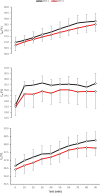Effectiveness of short-term isothermic-heat acclimation (4 days) on physical performance in moderately trained males
- PMID: 36395344
- PMCID: PMC9671432
- DOI: 10.1371/journal.pone.0270093
Effectiveness of short-term isothermic-heat acclimation (4 days) on physical performance in moderately trained males
Abstract
Introduction: A typical heat acclimation (HA) protocol takes 5-7 d of 60-90 minutes of heat exposure. Identifying the minimum dose of HA required to elicit a heat adapted phenotype could reduce financial constraints on participants and aid in the tapering phase for competition in hot countries. Therefore, the aim of this study was to investigate a 4 d HA regimen on physical performance.
Methods: Twelve moderately trained males were heat acclimated using controlled hyperthermia (Tre>38.5°C), with no fluid intake for 90 min on 4 consecutive days, with a heat stress test (HST) being completed one week prior to (HST2), and within one-week post (HST3) HA. Eleven completed the control study of HST1 versus HST2, one week apart with no intervention. Heat stress tests comprised of cycling for 90 min @ 40% Peak Power Output (PPO); 35°C; 60%RH followed by 10 minutes of passive recovery before an incremental test to exhaustion. Physical performance outcomes time to exhaustion (TTE), PPO, end rectal temperature (Tre END), and heart rate (HREND) was measured during the incremental test to exhaustion.
Results: Physiological markers indicated no significant changes in the heat; however descriptive statistics indicated mean resting Tre lowered 0.24°C (-0.54 to 0.07°C; d = 2.35: very large) and end-exercise lowered by 0.32°C (-0.81 to 0.16; d = 2.39: very large). There were significant improvements across multiple timepoints following HA in perceptual measures; Rate of perceived exertion (RPE), Thermal Sensation (TS), and Thermal Comfort (TC) (P<0.05). Mean TTE in the HST increased by 142 s (323±333 to 465±235s; P = 0.04) and mean PPO by 76W (137±128 to 213±77 W; P = 0.03).
Conclusion: Short-term isothermic HA (4 d) was effective in enhancing performance capacity in hot and humid conditions. Regardless of the level of physiological adaptations, behavioural adaptations were sufficient to elicit improved performance and thermotolerance in hot conditions. Additional exposures may be requisite to ensure physiological adaptation.
Copyright: © 2022 Shaw et al. This is an open access article distributed under the terms of the Creative Commons Attribution License, which permits unrestricted use, distribution, and reproduction in any medium, provided the original author and source are credited.
Conflict of interest statement
The authors have declared that no competing interests exist.
Figures







Similar articles
-
Influence of Exercise Heat Acclimation Protocol Characteristics on Adaptation Kinetics: A Quantitative Review With Bayesian Meta-Regressions.Compr Physiol. 2025 Jun;15(3):e70017. doi: 10.1002/cph4.70017. Compr Physiol. 2025. PMID: 40442924 Free PMC article. Review.
-
Impairment of Cycling Capacity in the Heat in Well-Trained Endurance Athletes After High-Intensity Short-Term Heat Acclimation.Int J Sports Physiol Perform. 2019 Sep 1;14(8):1058-1065. doi: 10.1123/ijspp.2018-0537. Int J Sports Physiol Perform. 2019. PMID: 30702375
-
Heat Reacclimation Using Exercise or Hot Water Immersion.Med Sci Sports Exerc. 2021 Jul 1;53(7):1517-1528. doi: 10.1249/MSS.0000000000002612. Med Sci Sports Exerc. 2021. PMID: 34127636 Free PMC article.
-
Short-term isothermic heat acclimation elicits beneficial adaptations but medium-term elicits a more complete adaptation.Eur J Appl Physiol. 2020 Jan;120(1):243-254. doi: 10.1007/s00421-019-04269-5. Epub 2019 Nov 25. Eur J Appl Physiol. 2020. PMID: 31768621 Free PMC article.
-
The Effects of Heat Adaptation on Physiology, Perception and Exercise Performance in the Heat: A Meta-Analysis.Sports Med. 2016 Nov;46(11):1699-1724. doi: 10.1007/s40279-016-0538-5. Sports Med. 2016. PMID: 27106556 Review.
Cited by
-
Combined Active and Passive Isothermic Heating Leads to Similar Core Temperature Compared With Exercise Alone.J Athl Train. 2025 May 1;60(5):372-380. doi: 10.4085/1062-6050-0448.24. J Athl Train. 2025. PMID: 39411876
-
Influence of Exercise Heat Acclimation Protocol Characteristics on Adaptation Kinetics: A Quantitative Review With Bayesian Meta-Regressions.Compr Physiol. 2025 Jun;15(3):e70017. doi: 10.1002/cph4.70017. Compr Physiol. 2025. PMID: 40442924 Free PMC article. Review.
References
-
- Moss JN, Bayne FM, Castelli F, Naughton MR, Reeve TC, Trangmar SJ, et al.. Short-term isothermic heat acclimation elicits beneficial adaptations but medium-term elicits a more complete adaptation. Eur J Appl Physiol. 2020;120(1):243–54. Epub 2019/11/27. doi: 10.1007/s00421-019-04269-5 . - DOI - PMC - PubMed
MeSH terms
Associated data
LinkOut - more resources
Full Text Sources
Medical
Miscellaneous

